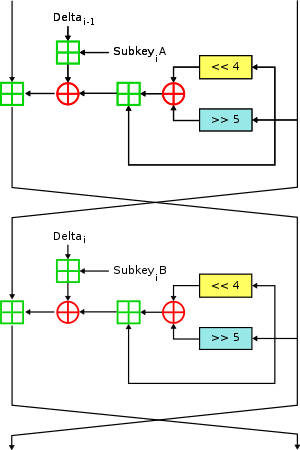Blowfish is a symmetric-key block cipher, designed in 1993 by Bruce Schneier and included in many cipher suites and encryption products. Blowfish provides a good encryption rate in software, and no effective cryptanalysis of it has been found to date. However, the Advanced Encryption Standard (AES) now receives more attention, and Schneier recommends Twofish for modern applications.

The Data Encryption Standard is a symmetric-key algorithm for the encryption of digital data. Although its short key length of 56 bits makes it too insecure for modern applications, it has been highly influential in the advancement of cryptography.
Differential cryptanalysis is a general form of cryptanalysis applicable primarily to block ciphers, but also to stream ciphers and cryptographic hash functions. In the broadest sense, it is the study of how differences in information input can affect the resultant difference at the output. In the case of a block cipher, it refers to a set of techniques for tracing differences through the network of transformation, discovering where the cipher exhibits non-random behavior, and exploiting such properties to recover the secret key.
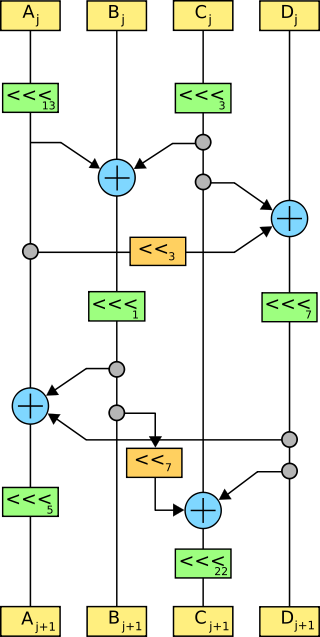
Serpent is a symmetric key block cipher that was a finalist in the Advanced Encryption Standard (AES) contest, in which it ranked second to Rijndael. Serpent was designed by Ross Anderson, Eli Biham, and Lars Knudsen.
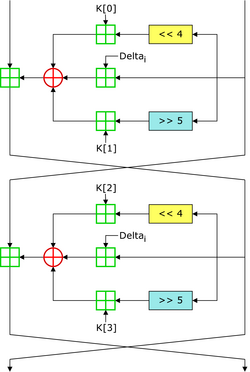
In cryptography, the Tiny Encryption Algorithm (TEA) is a block cipher notable for its simplicity of description and implementation, typically a few lines of code. It was designed by David Wheeler and Roger Needham of the Cambridge Computer Laboratory; it was first presented at the Fast Software Encryption workshop in Leuven in 1994, and first published in the proceedings of that workshop.
In cryptography, Camellia is a symmetric key block cipher with a block size of 128 bits and key sizes of 128, 192 and 256 bits. It was jointly developed by Mitsubishi Electric and NTT of Japan. The cipher has been approved for use by the ISO/IEC, the European Union's NESSIE project and the Japanese CRYPTREC project. The cipher has security levels and processing abilities comparable to the Advanced Encryption Standard.
Red Pike is a classified United Kingdom government encryption algorithm, proposed for use by the National Health Service by GCHQ, but designed for a "broad range of applications in the British government" Archived 2004-04-23 at the Wayback Machine. Little is publicly known about Red Pike, except that it is a block cipher with a 64-bit block size and 64-bit key length. According to the academic study of the cipher cited below and quoted in a paper by Ross Anderson and Markus Kuhn, it "uses the same basic operations as RC5" and "has no look-up tables, virtually no key schedule and requires only five lines of code"; "the influence of each key bit quickly cascades" and "each encryption involves of the order of 100 operations". 64 bits of key entropy are not considered secure anymore.
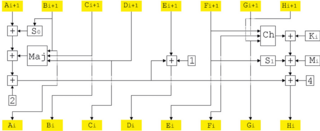
SHACAL-1 is a 160-bit block cipher based on SHA-1, and supports keys from 128-bit to 512-bit. SHACAL-2 is a 256-bit block cipher based upon the larger hash function SHA-256.

In cryptography, the boomerang attack is a method for the cryptanalysis of block ciphers based on differential cryptanalysis. The attack was published in 1999 by David Wagner, who used it to break the COCONUT98 cipher.
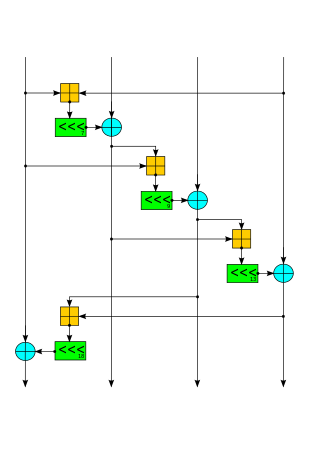
Salsa20 and the closely related ChaCha are stream ciphers developed by Daniel J. Bernstein. Salsa20, the original cipher, was designed in 2005, then later submitted to the eSTREAM European Union cryptographic validation process by Bernstein. ChaCha is a modification of Salsa20 published in 2008. It uses a new round function that increases diffusion and increases performance on some architectures.
In cryptography, higher-order differential cryptanalysis is a generalization of differential cryptanalysis, an attack used against block ciphers. While in standard differential cryptanalysis the difference between only two texts is used, higher-order differential cryptanalysis studies the propagation of a set of differences between a larger set of texts. Xuejia Lai, in 1994, laid the groundwork by showing that differentials are a special case of the more general case of higher order derivates. Lars Knudsen, in the same year, was able to show how the concept of higher order derivatives can be used to mount attacks on block ciphers. These attacks can be superior to standard differential cryptanalysis. Higher-order differential cryptanalysis has notably been used to break the KN-Cipher, a cipher which had previously been proved to be immune against standard differential cryptanalysis.
In cryptography, impossible differential cryptanalysis is a form of differential cryptanalysis for block ciphers. While ordinary differential cryptanalysis tracks differences that propagate through the cipher with greater than expected probability, impossible differential cryptanalysis exploits differences that are impossible at some intermediate state of the cipher algorithm.
In cryptography, integral cryptanalysis is a cryptanalytic attack that is particularly applicable to block ciphers based on substitution–permutation networks. It was originally designed by Lars Knudsen as a dedicated attack against Square, so it is commonly known as the Square attack. It was also extended to a few other ciphers related to Square: CRYPTON, Rijndael, and SHARK. Stefan Lucks generalized the attack to what he called a saturation attack and used it to attack Twofish, which is not at all similar to Square, having a radically different Feistel network structure. Forms of integral cryptanalysis have since been applied to a variety of ciphers, including Hierocrypt, IDEA, Camellia, Skipjack, MISTY1, MISTY2, SAFER++, KHAZAD, and FOX.
In cryptography, Zodiac is a block cipher designed in 2000 by Chang-Hyi Lee for the Korean firm SoftForum.
In cryptography, ARIA is a block cipher designed in 2003 by a large group of South Korean researchers. In 2004, the Korean Agency for Technology and Standards selected it as a standard cryptographic technique.
In cryptography, Spectr-H64 is a block cipher designed in 2001 by N. D. Goots, A. A. Moldovyan and N. A. Moldovyan. It relies heavily on the permutation of individual bits, so is much better suited to implementation in hardware than in software.
In cryptography, Treyfer is a block cipher/MAC designed in 1997 by Gideon Yuval. Aimed at smart card applications, the algorithm is extremely simple and compact; it can be implemented in just 29 bytes of 8051 machine code.

In cryptography, Corrected Block TEA is a block cipher designed to correct weaknesses in the original Block TEA.
This article summarizes publicly known attacks against block ciphers and stream ciphers. Note that there are perhaps attacks that are not publicly known, and not all entries may be up to date.
Prince is a block cipher targeting low latency, unrolled hardware implementations. It is based on the so-called FX construction. Its most notable feature is the alpha reflection: the decryption is the encryption with a related key which is very cheap to compute. Unlike most other "lightweight" ciphers, it has a small number of rounds and the layers constituting a round have low logic depth. As a result, fully unrolled implementation are able to reach much higher frequencies than AES or PRESENT. According to the authors, for the same time constraints and technologies, PRINCE uses 6–7 times less area than PRESENT-80 and 14–15 times less area than AES-128.
